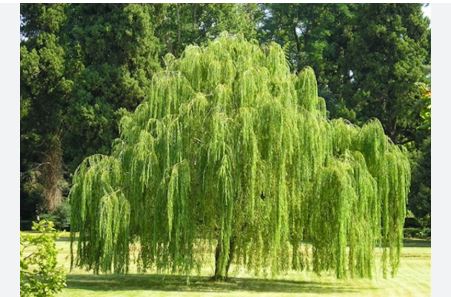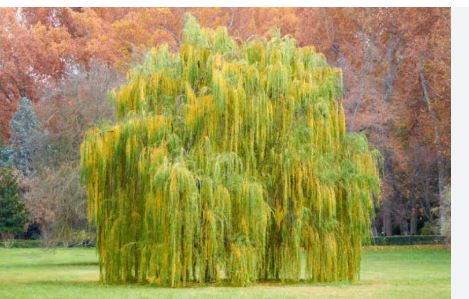
Australian Willow, scientifically known as Geijera parviflora, is a member of the Rutaceae family, which includes citrus plants and other aromatic species. It belongs to the genus Geijera, comprising about seven species of shrubs and trees native to Australia and New Caledonia. The species name parviflora derives from Latin, meaning “small-flowered,” referring to its inconspicuous blooms.
Geijera parviflora is distinct from true willows (Salix spp.) of the Salicaceae family, despite its common name, which reflects its willow-like foliage and weeping habit. Its classification within Rutaceae aligns it with plants like Zanthoxylum and Citrus, sharing traits like aromatic leaves and woody growth.
Geijera parviflora is an evergreen tree or large shrub, typically growing 20–35 feet tall and 20–30 feet wide, with a rounded, weeping canopy. Its narrow, lance-shaped leaves, 4–6 inches long and about 0.3 inches wide, are pale green, glossy, and hang downward, resembling willow foliage.
The leaves emit a mild citrus-like aroma when crushed, typical of the Rutaceae family. Small, creamy-white flowers appear in loose clusters in late winter to fall, but they are insignificant compared to the foliage. The bark is smooth, grayish-brown, and the tree’s drooping branches create a graceful, airy silhouette. Cultivars like ‘Gecko’ are more compact, suitable for smaller spaces.
Australian Willow is native to the warm, arid interior regions of Australia, including parts of Queensland, New South Wales, South Australia, and the Northern Territory. It grows naturally in dry woodlands, open forests, and scrublands, often on well-drained, sandy, or loamy soils with annual rainfall as low as 6–15 inches. Adapted to prolonged droughts, it thrives in harsh, low-water environments. Due to its ornamental appeal, it has been widely cultivated in Australia’s coastal and inland regions, as well as in the southwestern U.S. (e.g., California, Arizona), Mediterranean climates, and other dry regions globally, where it is valued in waterwise landscapes.
Geijera parviflora is hardy in USDA Zones 9–11, tolerating temperatures down to about 20°F (-6°C), though young trees may need protection from frost. It thrives in hot, dry climates with full sun, making it ideal for desert and Mediterranean regions like Southern California and the Inland Empire. In colder zones (e.g., Zone 8), it may suffer leaf or branch damage during freezes and is better grown in pots or with winter protection. Its heat and drought tolerance make it well-suited to low-water landscapes where consistent warmth is available.
Australian Willow is primarily an ornamental tree, prized for its graceful, weeping foliage and drought tolerance, making it a popular choice for shade, specimen planting, or street trees in waterwise gardens. It provides light, filtered shade, ideal for patios, lawns, or parking lot islands, and its low-branching habit can be trained for clearance in urban settings.
The tree is used for screening or as a foliage accent in xeriscapes, complementing plants like lavender or agaves. Its deep root system aids in erosion control on slopes. While not edible, the aromatic leaves have minor traditional uses, and the tree’s pest-free, deer-resistant nature enhances its appeal for low-maintenance landscapes in arid regions.

How To Grow And Care For Australian Willow
Select a Sunny Location
Choose a site with full sun, providing at least 6–8 hours of direct sunlight daily to ensure vigorous growth and dense foliage. Australian Willow tolerates light shade but performs best in open, sunny areas. Ensure the site accommodates its mature size, typically 20–35 feet tall and 20–30 feet wide, with space for its weeping branches to spread gracefully.
Ensure Well-Drained Soil
Plant in well-drained, sandy, or loamy soil with a pH of 6.0–8.0, as the tree is adapted to Australia’s arid soils. It tolerates poor, rocky soils but is susceptible to root rot in heavy clay or waterlogged conditions. Test soil drainage by filling a hole with water; it should drain within a few hours. Amend with sand or gravel if needed to improve drainage.
Plant in the Optimal Season
Plant in spring or early fall to promote root establishment before summer heat or winter cold. Dig a hole twice as wide and as deep as the root ball, positioning the root collar at ground level. Backfill with native soil, avoiding rich amendments, as the tree thrives in lean conditions. Water thoroughly and apply a light mulch layer to conserve moisture.
Water Sparingly After Establishment
Water deeply every 7–10 days during the first 1–2 years, providing 1–2 inches of water to encourage deep roots. Use drip irrigation or a soaker hose to target the root zone, avoiding trunk saturation. Once established, Australian Willow is highly drought-tolerant, requiring supplemental water only during extreme heat or extended dry periods (every 3–4 weeks).
Mulch with Inorganic Materials
Apply a 1–2-inch layer of inorganic mulch, such as gravel, decomposed granite, or small rocks, around the base, extending to the drip line but keeping it 3–4 inches from the trunk. Inorganic mulch mimics the tree’s native habitat, conserves moisture, reduces weeds, and prevents soil compaction without retaining excess water, which could harm roots.
Avoid Routine Fertilization
Australian Willow thrives in nutrient-poor soils and typically does not require fertilization. Excessive nutrients can lead to weak growth or reduced drought tolerance. If planted in extremely sandy or depleted soils, apply a low-nitrogen, slow-release fertilizer (e.g., 5-10-10) once in early spring during the first year, but discontinue thereafter to maintain its natural resilience.
Prune for Structure and Clearance
Prune lightly in late winter or early spring to shape the tree, remove dead or crossing branches, and maintain its weeping form. For street or patio use, lift the canopy by gradually removing lower branches to provide clearance, ensuring a balanced silhouette. Avoid heavy pruning, as the tree’s airy structure is part of its charm. Use clean, sharp tools to prevent disease.
Monitor for Pests
Australian Willow is virtually pest-free but may rarely attract aphids or scale insects in stressed conditions. Check for sticky residue, curled leaves, or small insects on foliage. Treat minor infestations with a strong water spray or insecticidal soap, ensuring good air circulation. Encourage natural predators like ladybugs to keep pest populations in check.
Prevent Root-Related Issues
The tree is susceptible to root rot (e.g., from Phytophthora) in poorly drained or overwatered soils. Ensure proper drainage and avoid frequent, shallow watering. If leaves yellow, wilt, or drop excessively, inspect the root zone for soggy conditions. Improve drainage or reduce watering; severe cases may require relocating the tree to a better-drained site.
Protect from Frost Damage
Hardy in Zones 9–11, Australian Willow tolerates light frosts but may suffer damage below 20°F (-6°C), especially when young. In Zone 8 or during rare freezes, cover young trees with frost cloth or burlap and mulch the root zone with gravel to insulate. In colder regions, grow in pots and move indoors during winter, maintaining temperatures above 20°F.
Support Pollinators
The tree’s small, creamy-white flowers, blooming from late winter to fall, attract bees and other pollinators. Avoid pesticides during flowering to protect these beneficial insects. Pair with low-water plants like salvia, lavender, or kangaroo paw to create a pollinator-friendly xeriscape, enhancing the garden’s ecological value.
Propagate with Seeds or Cuttings
Propagate Australian Willow via seeds or semi-hardwood cuttings. Collect seeds from mature pods in fall, scarify to break dormancy, and soak in warm water for 24 hours before planting in a sandy mix; germination takes 2–4 weeks. Cuttings taken in summer with rooting hormone can root in 6–8 weeks but are less reliable. Seeds are preferred for consistency.
Choose Appropriate Cultivars or Companions
Select cultivars like ‘Gecko’, a compact form (10–15 feet tall), for smaller spaces or containers. For standard trees, ensure nursery stock is labeled for upright or weeping habits to match your design. Pair with desert natives like agaves, yuccas, or penstemons to complement its fine texture and maintain a cohesive, low-water landscape.
Additional Tips
- Staking: Stake young trees in windy areas for the first year to stabilize roots, using flexible ties and removing stakes after establishment to promote trunk strength.
- Urban Use: Its deep roots and clean growth make it ideal for streetscapes or parking lots, but ensure clearance for pedestrians or vehicles.
- Long-Term Care: With a lifespan of 20–30 years, regular monitoring for overwatering or storm damage ensures longevity. Plant in groups or as a focal point for maximum impact.